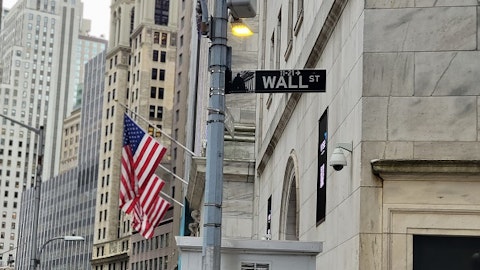Alpine Income Property Trust, Inc. (NYSE:PINE) Q1 2024 Earnings Call Transcript April 19, 2024
Alpine Income Property Trust, Inc. isn’t one of the 30 most popular stocks among hedge funds at the end of the third quarter (see the details here).
Operator: Good day, and thank you for standing by. Welcome to the Alpine Q1 2024 Earnings Call. At this time, all participants are in a listen-only mode. After the speaker’s presentation, there will be a question-and-answer session. [Operator Instructions] Please be advised that today’s conference is being recorded. I would now like to hand the conference over to your speaker, Lisa Vorakoun, Chief Accounting Officer. Please go ahead.
Lisa Vorakoun: Good morning, everyone, and thank you for joining us today for the Alpine Income Property Trust’s first quarter 2024 operating results conference call. With me today is our CEO and President, John Albright. Before we begin, I’d like to remind everyone that many of our comments today are considered forward-looking statements under federal securities law. The company’s actual future results may differ significantly, from the matters discussed in these forward-looking statements, and we undertake no duty to update these statements. Factors and risks that could cause actual results to differ materially from expectations are disclosed from time-to-time in greater detail in the company’s Form 10-K, Form 10-Q and other SEC filings.
You can find our SEC reports, earnings release and most recent investor presentation, which contain reconciliations of the non-GAAP financial measures we use on our website at alpinereit.com. Now, I’d like to turn the call over to John for his prepared remarks.
John Albright: Thanks, Lisa, and good morning, everyone. I’d like to start off by thanking our former CFO, Matt Partridge, for his many contributions to our company. We wish him well with his new opportunity. We have engaged a national firm to search for a new CFO and have started interviewing candidates. Reviewing our first quarter investment activity, although the traditional acquisition market was quiet for us during the quarter, we did originate a $7.2 million first mortgage loan investment, of which $3.6 million was funded during the quarter. We also acquired the land under our CVS in Baton Rouge for $1 million. The initial yield on our loan investment was 11.3%, and the cash cap rate for our land acquisition was 7.3%. The loan investment made during the quarter was to provide a $7.2 million of funding with a two-year term towards a six pad retail development anchored by Chick-fil-A in a growing sub-market of Atlanta, Georgia.
On the property acquisition front, we saw fewer attractive core investment opportunities due to the reluctant sellers. However, we anticipate that as the market further adjusts to higher for longer rates, the transaction market may become more productive for us. We are seeing additional high-yielding and better risk-adjusted loan opportunities which we expect to pursue in the second quarter. As of the end of the quarter, our portfolio was 99% occupied and consisted of 138 properties totaling 3.8 million square feet with tenants operating in 23 sectors within 35 states. Our top tenants remain unchanged from our year-end earnings call in mid-February with Walgreens, Lowe’s, Dick’s Sporting Goods, Family Dollar, Dollar Tree, and Dollar General as our top five tenants, all of whom carry investment-grade credit ratings.
We ended the quarter with 65% of our total annualized base rents coming from tenants with an investment-grade credit rating, which is an increase of 700 basis points from this time last year. We have a strong balance sheet and no debt maturity until 2026, and this stability compliments the strength of our high-quality portfolio. I also want to highlight the valuation discount with our current stock price trading at approximately $15 a share, which is an implied cap rate of over 8.5% and a current dividend yield of over 7.25%. Considering our book value is over $18 per share, and in the past year we have repurchased almost a million shares or over 6% of our company’s capitalization at an average price of approximately $16.25 per share, we believe Alpine stock provides an attractive value and yield investment, which we will work on better communicating with the investment community in the near future.

On the disposition side, we’re starting to see more activity on some of the assets we would like to sell and recycle into higher yielding opportunities. This recycling of capital to organically grow earnings should be an active area for us this year. With that, I’ll now turn it over to Lisa to talk about our first quarter performance, balance sheet, capital markets, and guidance.
Lisa Vorakoun: Thanks, John. Beginning with our financial results, first quarter 2024 FFO was $0.41 per share, a $0.05 per share or 13.9% increase over the first quarter of 2023. First quarter 2024 AFFO was $0.42 per share, a $0.06 per share increase or 16.7% increase over the first quarter of 2023. Our results benefited from an 11.7% increase in total revenues, which was primarily driven by the interest income generated by our loan portfolio. While our seven former Mountain Express properties still created a negative impact on our lease income revenues as compared to the first quarter of 2023, rent on three leases with new operators commenced during the quarter, and we anticipate a fourth lease will commence during the second half of 2024.
We are in active discussion for the potential lease or sale of the remaining three properties. G&A as a percentage of revenues in the first quarter was 12.4%, a year-over-year decrease of nearly 121 basis points. Our G&A benefited from our reduced external management fee as a result of our recent share repurchases. For the first quarter of 2024, the company paid a cash dividend of $0.275 per share, representing a current annualized yield of over 7.25%. FFO and AFFO first quarter payout ratios were 67% and 65% respectively, down from 76% in the first quarter of last year. We anticipate announcing our regular quarterly cash dividend for the second quarter towards the end of May. We repurchased over 45,000 shares of common stock on the open market for a total cost of $800,000 at an average price of $16.90 per share, which completed the previously authorized $15 million share repurchase program.
As we previously discussed, our balance sheet is well-stabilized with no debt maturities until 2026, and total liquidity at quarter end was $185 million. We ended the quarter with net debt to total enterprise value of 54%, net debt to pro forma EBITDA of 7.4 times, and our fixed charge coverage ratio remains very healthy at 3.4 times. As we look forward to the balance of 2024, we begin the second quarter with portfolio-wide, in-place, annualized straight-line base rent of $38.9 million, or $38.5 million of in-place, annualized cash base rent, as well as annualized interest income from loan investments of $3.6 million. We maintained our full-year FFO and AFFO guidance of $1.51 to $1.56 per share, and $1.53 to $1.58 per share, respectively. Our investment guidance remains unchanged at a range of $50 million to $80 million of investments, contingent on reasonable market conditions, and includes the potential for additional loan investments.
Our disposition’s guidance also remains unchanged at a range of between $50 million and $80 million. With that, I’ll now turn the call back over to John for his closing remarks.
John Albright: Thanks, Lisa. Overall, we’re confident our unique asset recycling strategy, ample liquidity, de-risk balance sheet, and high-quality portfolio has us well positioned to drive value over the long run, and we look forward to executing on our 2024 guidance and positioning us for future earnings growth in 2025. I want to thank the team for their hard work and our shareholders and business partners for their continued support. With that, operator, please open the line for questions.
See also 15 Best Places to Retire in Ontarioa and 10 Best Healthcare Stocks to Buy Under $20.
Q&A Session
Follow Alpine Income Property Trust Inc.
Follow Alpine Income Property Trust Inc.
Operator: Certainly. [Operator Instructions]. And one moment for our first question. Our first question will be coming from Gaurav Mehta of Alliance Global Partners. Your line is open.
Gaurav Mehta : Thanks, good morning.
John Albright : Good morning.
Gaurav Mehta: I wanted to ask you on your acquisition guidance and your comments on the traditional acquisition opportunities that you’re seeing in the market. I was wondering how much are you willing to grow your loan portfolio in the event you don’t see attractive traditional acquisition opportunities.
John Albright: Yeah, so it’s a good question. We are seeing a little bit more movement in the market, so we are optimistic that we’ll be able to definitely hit our acquisition targets. We’re seeing a little bit more movement as well on some of the properties that we’d like to sell. So we’re optimistic that we’ll be able to sell some non-IG credits and recycle into IG credits. So we’re pretty comfortable with what we’re seeing in the market as now that rates are sticking with kind of a higher trajectory. I think folks that have business plans that maybe they were hoping on a little better rate environment are just going to go ahead and start moving with their business plans.
Gaurav Mehta: Okay, second question I have is on the guidance, maybe on the 1Q $0.41, the FFO that you reported. I was just wondering what are some of the assumptions for the remaining year that takes you from $0.41 sort of run rate to $1.51, $1.56 guidance?
John Albright: Yeah, so look, we got a lot of questions on that appropriately. So a little bit of the earnings model is that we expect to sell assets and have a lag on the acquisitions. So we’ll be missing some revenue as we sell assets in escrow as we’re waiting to acquire assets. And a little bit of it is really kind of on the loan side, on the Micromont loan, that loan is set up more as a short-term loan as the borrower would like to sell the assets, and as they sell the assets, it hyper-amortizes our loan. And so if they become more active in selling assets, we’ll lose the income from that loan investment if we don’t replace it. And a little bit from on the G&A side with — from the higher audit and tax fees later in the year.
But in general, we are being a little bit conservative. Obviously, Matt left at the end of March, and we were not looking to kind of do a lot of remodeling and so forth, so we’re early in the year. And if it’s appropriate, obviously, next quarter, we’ll revisit it.
Gaurav Mehta: Okay, thank you.
John Albright: Thank you.
Operator: And one moment for our next question. And our next question will be coming from Jason Weaver of JonesTrading. Jason, your line is open.
Jason Weaver : Hi, good morning. I was hoping, can you give us any color about upcoming rental rate increases over the balance of the year, and if you expect any lease turnovers during the same?
John Albright: Yeah, I mean, we have very little lease turnover this year. We have a theater in Reno at the end of November, so there’ll be only one month of lag there. But everything else is pretty much, not a lot of lease turnover, if you will, for this year. On basically the rent increase, obviously, we’re roughly about a point a year as far as rent escalations over the balance of the whole portfolio. As you kind of think about it, a lot of our — we do have some flat leases, and we have some leases that escalate every five years, and on kind of an aggregate basis, it’s usually a percent.
Jason Weaver : Got it, thank you for that color. And then the next one’s a hypothetical. If we remain in this depressed sort of transaction environment for much longer, how do you look at the priority for capital deployment between acquiring new retail loans versus share repurchase?
John Albright: Yeah, so obviously we were very active on the share repurchases last year and a little bit in the quarter. We’ll basically, the board obviously discusses that on a quarterly basis, and we’ll see how we start out this quarter and see how things go. But we are seeing some very, I would say opportunistic loan opportunities that we’d like to execute where we’re getting very high risk-adjusted yields. And so that’s a good way to kind of deploy capital, have some strong free cash flow as we wait and see if there’s some opportunities on the core acquisition side. So we’ll try to balance that. Don’t want to go incredibly into the share buyback side, but if the stock kind of presents more opportunity, kind of like where it is now, we may revisit that for sure.
Jason Weaver : All right, thank you for taking my question.
John Albright: Sure.
Operator: And one moment for our next question. Our next question will come from Rob Stevenson of Janney Montgomery Scott. Rob, your line is open.
Rob Stevenson : Good morning. John, I guess with respect to the loans, is there any sort of upper boundary that you and the board have at this point, or is it case by case? How are you guys thinking about how big of a loan exposure you would want to have sitting here over the next year or two?
John Albright: Yeah, so we’re almost there. Given our credit facilities kind of limit us on how much of the loan activity we can do. So the upward bounds of that exposure is roughly $10 million from where we are now. Now, we may be recycling some of the loans as we see opportunities, but the aggregate amount is, call it in the mid-50s.
Rob Stevenson : Okay, that’s helpful. And then, at this point, given your comments about the reluctance of sellers, how are you feeling about the ability for buyers of your disposition assets to be able to fund that given where rates have moved to and sort of tighter purse strings by the banks, etc. How robust is that market and is that going to be a delaying factor for you guys in selling some of the assets this year?



